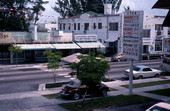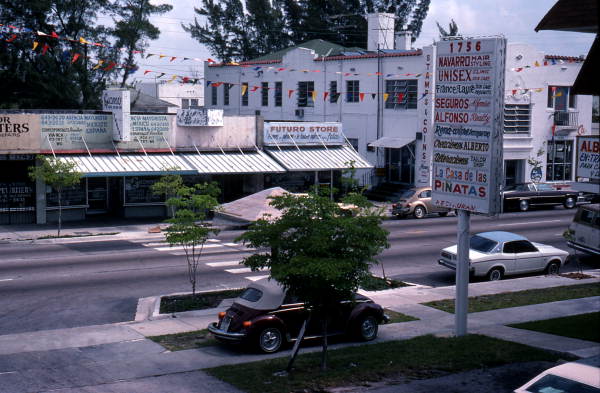Florida Memory is administered by the Florida Department of State, Division of Library and Information Services, Bureau of Archives and Records Management. The digitized records on Florida Memory come from the collections of the State Archives of Florida and the special collections of the State Library of Florida.

State Archives of Florida
- ArchivesFlorida.com
- State Archives Online Catalog
- ArchivesFlorida.com
- ArchivesFlorida.com
State Library of Florida
Related Sites
Image Number
Photographer
Date
Collection
"Little Havana" : Folklife in Miami Slide/Tape Program
Geographic Term
Subject Term
Community culture--Florida--Dade County--Miami--Little Havana
City and town life
Hispanic American neighborhoods
Ethnic neighborhoods
Neighborhoods--Florida--Dade County--Miami--Little Havana
Signs and signboards--Florida--Dade County--Miami--Little Havana
Cuban American business enterprises--Florida--Dade County--Miami--Little Havana
Central business districts--Florida--Dade County--Miami--Little Havana
Commercial buildings--Florida--Dade County--Miami--Little Havana
Corporate Subject
Physical Description
General Note
Accompanying note: "Latin Miami is the second largest Cuban populated city in the world, only Havana is larger. In the past twenty years, 75% of Miami's growth has been due to Latin (particularly Cuban) immigration. This astonishing immigration gives Miami its cosmopolitan, Latin character."
Accompanying note: "'Little Havana' is a section of Miami located just south of downtown, bordered by Calle Ocho to the north and Coral Gables to the south. Formerly an area of decaying neighborhoods and shuttered businesses, 'Little Havana' exists today as a thriving Latin marketplace and tourist attraction, while serving as home to over one-quarter of metropolitan Dade County's Hispanic population."
"Studies reveal that 40% of all Cuban refugees who have settled in other parts of the U.S. eventually have moved to Miami. Three reasons are cited repeatedly for this migration: climate, proximity to friends and family, and the cultural environment. These factors play an essential role in creating an ethnic community with cohesive values and lifestyle. Social scientists now recognize the fallacy of the 'melting pot' theory. In the United States we are a nation of many nationalities. Far from blending into a homogeneous "American" character, we have strong ties to ethnic, religious, and place-specific heritage. 'Little Havana' is an example of one group's solution to the need for continuity and tradition in a new environment."
"As folklorists have begun to work within the urban communities of America, we have just begun to explore the complex cultural exchanges that occur in the city. In 'Little Havana' we can see the retention of older traditions from Cuba as well as the emergence of new, indigenous folklore. Each city creates a folk cultural complex composed of the traditions of its various inhabitants."

Order Prints
Please select the size and options
Order Scan
Please select the size and options
Title
Subject
Creator
Date
Identifier
Image URL
Thumbnail
Geographic Term
Color
Physical Description
Series Title
General Note
Subject - Corporate
Collection ID
Chicago Manual of Style
Bulger, Peggy A. A section of downtown Little Havana - Miami, Florida. 1980 (circa). State Archives of Florida, Florida Memory. <https://www.floridamemory.com/items/show/120161>, accessed 13 October 2025.
MLA
Bulger, Peggy A. A section of downtown Little Havana - Miami, Florida. 1980 (circa). State Archives of Florida, Florida Memory. Accessed 13 Oct. 2025.<https://www.floridamemory.com/items/show/120161>
AP Style Photo Citation
(State Archives of Florida/Bulger)

 Listen: The Folk Program
Listen: The Folk Program